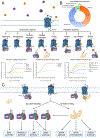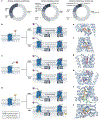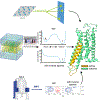Functional dynamics of G protein-coupled receptors reveal new routes for drug discovery
- PMID: 39747671
- PMCID: PMC11968245
- DOI: 10.1038/s41573-024-01083-3
Functional dynamics of G protein-coupled receptors reveal new routes for drug discovery
Abstract
G protein-coupled receptors (GPCRs) are the largest human membrane protein family that transduce extracellular signals into cellular responses. They are major pharmacological targets, with approximately 26% of marketed drugs targeting GPCRs, primarily at their orthosteric binding site. Despite their prominence, predicting the pharmacological effects of novel GPCR-targeting drugs remains challenging due to the complex functional dynamics of these receptors. Recent advances in X-ray crystallography, cryo-electron microscopy, spectroscopic techniques and molecular simulations have enhanced our understanding of receptor conformational dynamics and ligand interactions with GPCRs. These developments have revealed novel ligand-binding modes, mechanisms of action and druggable pockets. In this Review, we highlight such aspects for recently discovered small-molecule drugs and drug candidates targeting GPCRs, focusing on three categories: allosteric modulators, biased ligands, and bivalent and bitopic compounds. Although studies so far have largely been retrospective, integrating structural data on ligand-induced receptor functional dynamics into the drug discovery pipeline has the potential to guide the identification of drug candidates with specific abilities to modulate GPCR interactions with intracellular effector proteins such as G proteins and β-arrestins, enabling more tailored selectivity and efficacy profiles.
© 2025. Springer Nature Limited.
Conflict of interest statement
Competing interests: S.Y. is cofounder of AlphaMol Science Ltd. C.G.T. is a shareholder, consultant and member of the Scientific Advisory Board of Sosei Heptares. The remaining authors declare no competing interests.
Figures







References
-
- Lander ES et al. Initial sequencing and analysis of the human genome. Nature 409, 860–921 (2001). - PubMed
-
- FDA. Summary of NDA Approvals & Receipts, 1938 to the present. https://www.fda.gov/about-fda/histories-fda-regulated-products/summary-n... (2024).
Publication types
MeSH terms
Substances
Grants and funding
LinkOut - more resources
Full Text Sources

